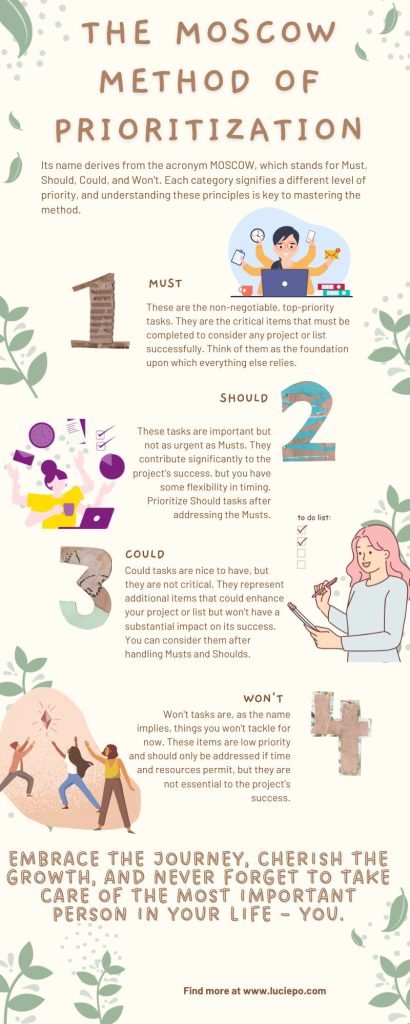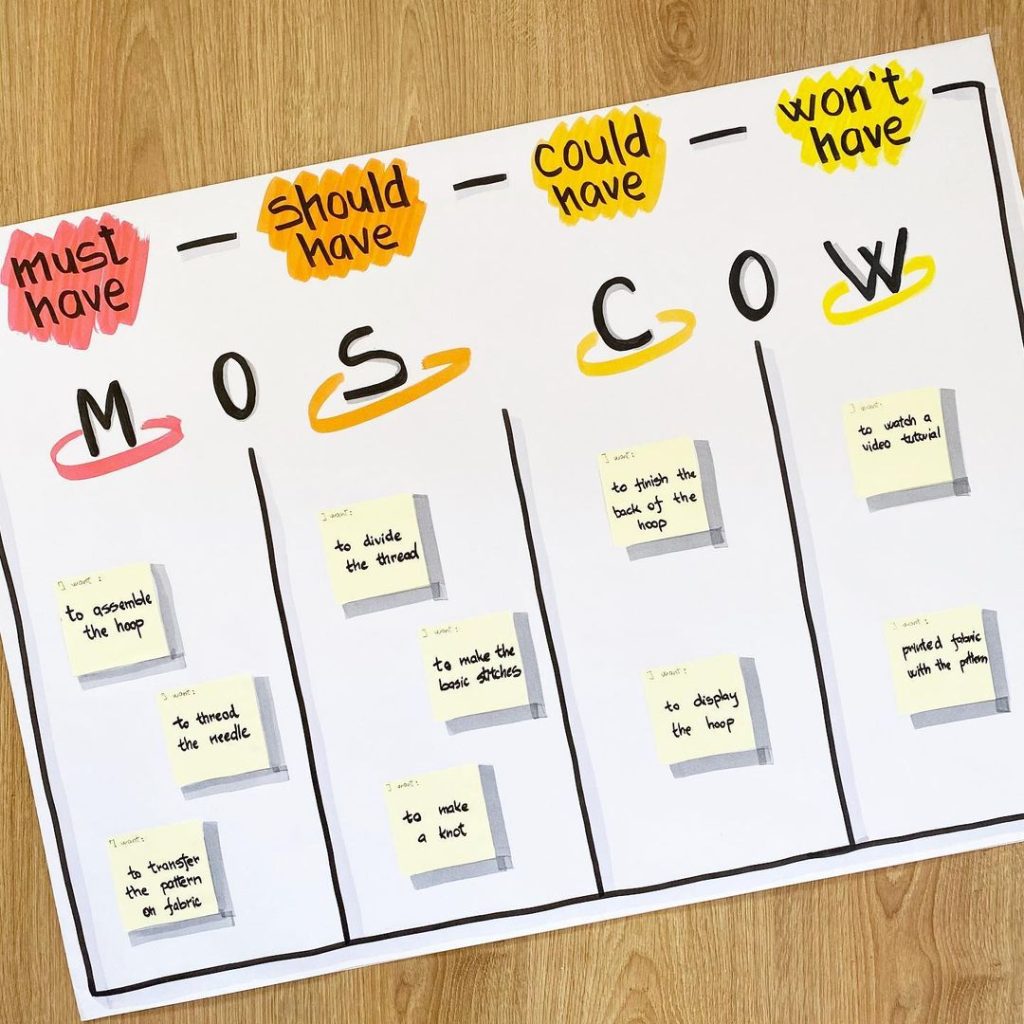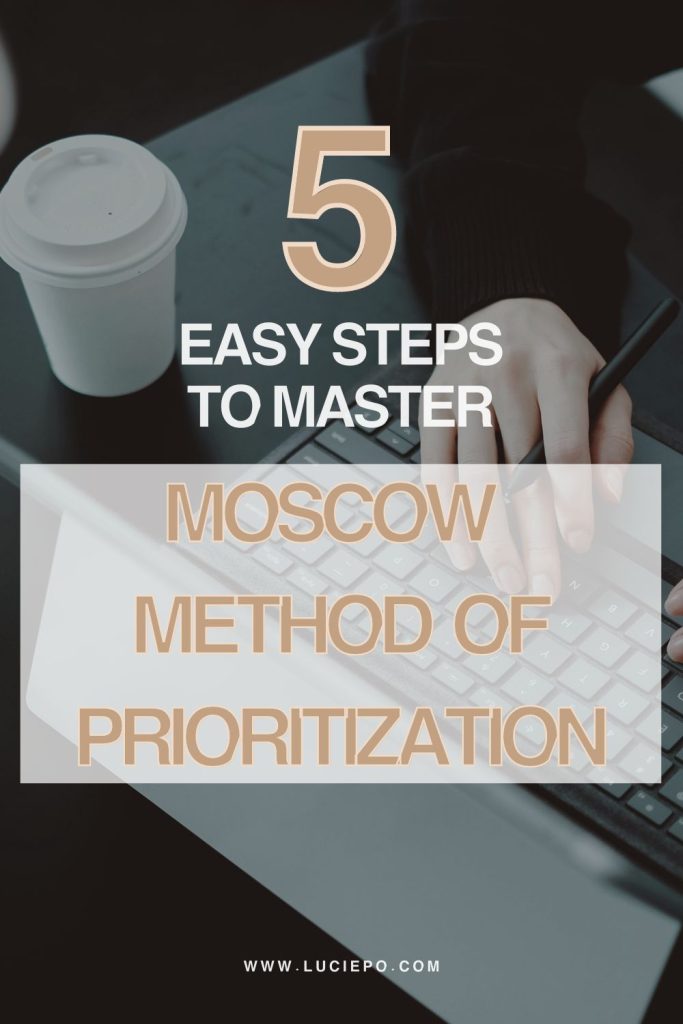
5 Powerful Tips for Moscow Method Of Prioritization for Superior Results
Ever had those days when you feel like you’re juggling a million things at once, and it’s a struggle to keep up?
I know I have.
It’s like a never-ending race against the clock. But guess what? I’ve found a way to not just survive but thrive in the midst of chaos.
In this blog post, I’m excited to share with you my favorite prioritization technique called Moscow Method.
By the time you finish reading, you’ll have a firm grasp of how to prioritize tasks effectively, whether you’re managing a complex project at work or simply trying to tackle your daily to-dos.
If you want to learn more about the Moscow Method of prioritization, check out my curated list of fav tools and resources:
- Books: Dive into books like “Smarter Faster Better” by Charles Duhigg or “Getting Things Done” by David Allen for in-depth insights on time management and prioritization.
- Online Courses: Platforms like Coursera and Udemy offer courses on time management and productivity that can complement your learning.
- Productivity Apps: Utilize apps like Notion, Avaza, or TickTick to implement the Moscow Method digitally and enhance your task management.
- Productivity Blogs: Explore blogs like Lifehacker, or Brian Tracy’s blog for ongoing tips and advice on productivity and task prioritization.
- Time Management Coaches: Consider seeking guidance from a certified time management coach who can provide personalized strategies for implementing the Moscow Method effectively.
Understanding the Moscow Method
It’s a powerful and practical prioritization technique that can help you regain control of your to-do list and achieve superior results in your tasks and projects.
Origins and Principles
Its name derives from the acronym MOSCOW, which stands for Must, Should, Could, and Won’t. Each category signifies a different level of priority, and understanding these principles is key to mastering the method.
- Must (M): These are the non-negotiable, top-priority tasks. They are the critical items that must be completed to consider any project or list successfully. Think of them as the foundation upon which everything else relies.
- Should (S): These tasks are important but not as urgent as Musts. They contribute significantly to the project’s success, but you have some flexibility in timing. Prioritize Should tasks after addressing the Musts.
- Could (C): Could tasks are nice to have, but they are not critical. They represent additional items that could enhance your project or list but won’t have a substantial impact on its success. You can consider them after handling Musts and Shoulds.
- Won’t (W): Won’t tasks are, as the name implies, things you won’t tackle for now. These items are low priority and should only be addressed if time and resources permit, but they are not essential to the project’s success.
Understanding these principles allows you to categorize and prioritize tasks effectively, ensuring that you focus your energy and resources on what truly matters.
Benefits of using the Moscow Method of Prioritization
Implementing the Moscow Method of Prioritization offers a range of valuable benefits for individuals and organizations alike. Here are some key advantages:
- Clarity and Focus: The Moscow Method provides a structured framework for categorizing and prioritizing tasks. This clarity helps you understand what needs to be done first, reducing overwhelm and promoting focus on the most critical objectives.
- Efficient Resource Allocation: By distinguishing between Must, Should, Could, and Won’t tasks, you can allocate your time, energy, and resources more efficiently. This ensures that you’re not wasting valuable resources on less important items.
- Improved Decision-Making: When faced with choices or project requirements, the Moscow Method guides your decision-making process. It helps you determine which tasks align most closely with your goals and overall success.
- Enhanced Productivity: Prioritizing Must tasks ensures that essential work gets done promptly. This boosts productivity and prevents procrastination on critical assignments.
- Reduced Stress: Knowing what truly matters and having a clear plan for addressing Must and Should tasks can reduce stress and anxiety. You’ll have confidence in your priorities and be less likely to feel overwhelmed.
- Greater Accountability: The Moscow Method fosters a sense of responsibility. When tasks are clearly categorized, it’s easier to track progress and hold yourself or your team accountable for completing Must and Should items.
- Optimized Time Management: The method encourages efficient time management by focusing on the most significant tasks first. This can lead to better time utilization and the ability to tackle more tasks within a given timeframe.
- Flexibility: While the Moscow Method emphasizes priority, it doesn’t disregard Could and Won’t tasks. It acknowledges that there may be room for less urgent but valuable items in your plans, allowing for flexibility when appropriate.
- Project Success: When applied to project management, the Moscow Method increases the likelihood of project success by ensuring that critical requirements are met before addressing additional features or enhancements.
- Effective Communication: Whether you’re working in a team or communicating with stakeholders, using the Moscow Method facilitates clear communication about task priorities and expectations.

How the Moscow Method Differs from Other Prioritization Methods
In my journey of mastering time management and prioritization, I’ve encountered several techniques. What sets the Moscow Method apart is its unique approach to handling tasks and objectives. Here’s how it differs from other prioritization methods:
- Focus on Musts: Unlike some methods that divide tasks into mere ‘urgent’ or ‘important’ categories, the Moscow Method goes further by emphasizing ‘Must’ tasks. It draws a clear line between what absolutely must be done and what can wait, preventing confusion and ensuring top-priority items are crystal clear.
- Layered Approach: While methods like the Eisenhower Matrix or ABCD prioritization focus on a single layer of urgency, the Moscow Method employs a multi-layered structure. It not only considers the Musts and Shoulds but also the Coulds and Won’ts, providing a more nuanced perspective on task importance.
- Adaptability: One standout feature of the Moscow Method is its adaptability. It’s versatile enough to be used for personal task management, project prioritization, and even product development. This adaptability makes it suitable for various scenarios and scales.
- Holistic Outlook: Unlike methods that might lead to neglecting lower-priority tasks entirely, the Moscow Method encourages a holistic view. It recognizes that Could and Won’t tasks may have their place, allowing for flexibility without losing sight of essential goals.
- Balanced Approach: Some methods can lead to overemphasizing urgency or importance, potentially neglecting other aspects of life or work. The Moscow Method encourages a balanced approach, ensuring that critical tasks are addressed while still allowing space for less pressing matters.
Step 1: Identify Must-Do Tasks
Alright, let’s dive into the nitty-gritty of applying the Moscow Method. It all starts with the first step: identifying your Must-Do tasks. Here’s how I go about it:
- Task Brainstorm: I begin by listing down all the tasks, activities, or objectives I need to tackle. This can range from work-related projects to personal goals, errands, or even fun activities. The key is not to filter anything out at this stage; we’ll do that later.
- Critical Evaluation: Once I have my list, I take a moment to critically evaluate each item. I ask myself, “Is this absolutely essential? Does it align with my core goals and priorities?” If the answer is a resounding yes, it goes into the ‘Must-Do’ category. These are non-negotiables, the tasks that hold the highest importance and urgency.
- Be Selective: It’s important not to overwhelm yourself with too many ‘Must-Do’ tasks. In this step, quality often triumphs over quantity. By being selective and focusing on a manageable number of Musts, you set yourself up for success.
- Document and Organize: I like to keep my ‘Must-Do’ tasks organized. Whether it’s a digital task manager, a good old notebook, or a productivity app, having a dedicated space for Musts ensures they don’t get lost in the shuffle.
- Review and Reevaluate: Lastly, remember that priorities can change. Regularly reviewing and reevaluating your ‘Must-Do’ tasks keeps you aligned with your goals and helps you adapt to evolving circumstances.
Example: Your ‘Must-Do’ tasks could include meeting an important work deadline and sticking to your daily workout routine.
Step 2: Should-Do Tasks
Now that we’ve identified our ‘Must-Do’ tasks, it’s time to move on to the next level of prioritization: the ‘Should-Do’ tasks. Here’s how I approach this step:
- Definition: ‘Should-Do’ tasks are important but not as time-sensitive or critical as ‘Must-Do’ tasks. These are the items that, while significant, won’t have catastrophic consequences if delayed a bit. They are tasks that align with your goals and values but offer some flexibility in their completion timeline.
- Review ‘Should-Do’ List: Similar to the first step, I start by listing all my ‘Should-Do’ tasks. These are tasks that are important for my long-term objectives but don’t require immediate attention.
- Comparison: I then take a close look at my ‘Should-Do’ list alongside my ‘Must-Do’ tasks. This is where the Moscow Method shines. I compare each ‘Should-Do’ task against my ‘Must-Do’ tasks and ask, “Is this more important than any of my Musts?” If a ‘Should-Do’ task surpasses the significance of a ‘Must-Do,’ it can earn a promotion to the ‘Must-Do’ category.
- Time Allocation: It’s essential to allocate time for your ‘Should-Do’ tasks in your schedule. While they might not be as urgent as Musts, they should still have a dedicated spot in your day or week. This ensures you don’t neglect them for too long.
- Flexibility and Adaptability: ‘Should-Do’ tasks often require more flexibility. They might be long-term projects, personal growth activities, or creative pursuits. Embrace the adaptability of these tasks and allow yourself the freedom to explore and enjoy them at your own pace.
- Keep the Balance: Balancing ‘Must-Do’ and ‘Should-Do’ tasks is key to a well-rounded and fulfilling life. While Musts keep you on track and productive, Shoulds add depth and meaning to your journey.
Example: You also have ‘Should-Do’ tasks, such as responding to work emails, grocery shopping, and making time for self-care.
Step 3: Could-Do Tasks
Now we’re diving deeper into the Moscow Method with the ‘Could-Do’ tasks. These are the tasks that offer a realm of possibilities and creativity. Here’s how I approach this step:
- Defining ‘Could-Do’: ‘Could-Do’ tasks are, as the name suggests, the ones that you could do if you have some extra time and energy left after dealing with your ‘Must-Do’ and ‘Should-Do’ tasks. They are often the tasks that add a sprinkle of excitement and novelty to your routine.
- Compiling ‘Could-Do’ List: Start by jotting down all the ‘Could-Do’ tasks you can think of. These can be hobbies, side projects, spontaneous adventures, or even activities that feed your curiosity. This list is like a treasure chest of possibilities.
- Prioritizing Creativity: The ‘Could-Do’ tasks are your playground for creativity and personal growth. I love to prioritize tasks here that challenge me or help me explore new horizons. It could be learning a new language, picking up a musical instrument, or starting that blog you’ve always thought about.
- No Pressure, All Pleasure: Remember, the beauty of ‘Could-Do’ tasks is that there’s no pressure attached. You do them because you want to, not because you have to. This removes any stress and allows you to enjoy these activities fully.
- Schedule Your ‘Could-Do’ Time: Just like with ‘Should-Do’ tasks, allocate specific time for your ‘Could-Do’ adventures. It could be a few hours a week or an entire weekend dedicated to your creative pursuits. Having this dedicated time ensures you don’t forget about them.
- Explore and Reevaluate: ‘Could-Do’ tasks are flexible and ever-evolving. As you explore them, you might find new passions or interests. Embrace this fluidity and don’t hesitate to shuffle tasks around.
- The Joy of Discovery: This category is where you discover more about yourself, your interests, and your potential. It’s a reminder that life is not just about tasks and responsibilities; it’s about the joy of discovery.
Example: Now, consider ‘Could-Do’ tasks, like exploring a new hobby or volunteering for a local charity.
Step 4: Delegate or Delay Tasks
Ah, the magic of delegation and the wisdom of delaying! This step is all about assessing the remaining tasks on your list and deciding their fate. As always, I’ll share how I tackle this phase with a sprinkle of personal touch:
- Delegate with Grace: Begin by examining the tasks that you neither have to do yourself nor are eager to do. Delegation is like having a trustworthy sidekick. Assign tasks to someone who’s capable and willing, whether it’s a colleague, a family member, or a friend. The key here is not just to offload but to empower others and strengthen your teamwork.
- Delegate Thoughtfully: When you delegate, be clear in your communication. Specify the task, the expected outcome, and any deadlines or guidelines. Effective delegation ensures that responsibilities are understood and executed well.
- Review and Follow-Up: Delegation doesn’t mean you wash your hands of the task. Stay involved, provide support if needed, and review the progress. Effective delegation is a partnership, and your guidance can make all the difference.
- Embrace the Freedom: Delaying tasks is a strategic move. It’s about recognizing that some things can wait. This allows you to focus your energy on your ‘Must-Do’ and ‘Should-Do’ tasks without spreading yourself too thin.
- Revisit Regularly: Your list isn’t set in stone. Regularly revisit the tasks you’ve delegated or delayed. Conditions change, and what was once a ‘Could-Do’ or a ‘Delay’ might move up in priority. Flexibility is your ally.
- Celebrate Progress: Celebrate your ability to delegate and delay effectively. It’s a sign of your growing prioritization skills and your commitment to staying focused on what truly matters.
Example: You decide to delegate the grocery shopping to a delivery service, freeing up time for both work and your workout routine.
Step 5: Eliminate or Accept Tasks
Ah, the pivotal moment where you unfurl your final act in the Moscow Method saga: eliminating or accepting tasks. This step is like the grand finale of a captivating performance. As always, I’m here to share how I navigate this phase with a sprinkle of personal insight:
Eliminate
You’ve been holding onto a side project for months, hoping it’ll sprout wings and soar. But deep down, you know it’s draining your energy and adding unnecessary clutter to your life. This is where elimination steps in – recognizing when it’s time to bid farewell to tasks that no longer serve your purpose.
Accept
Some tasks might not be glamorous, but they’re essential. Take, for instance, managing your finances or doing the laundry. These aren’t the most exciting endeavors, but they’re part and parcel of daily life. Embracing them is about acknowledging that these tasks, while mundane, contribute to your overall well-being.
Example: Let’s say you initially thought about attending a social event on the same evening as your work deadline. Considering your busy schedule, you realize that attending would add unnecessary stress. So, you accept that it’s better to skip the event and prioritize your work commitments.
Putting It All Together
Now it’s time to assemble your task list, create a prioritization action plan, and leverage visual aids to bring your newfound skills to life. With these tools at your disposal, you’ll be orchestrating a symphony of productivity and efficiency in no time.
Developing a Prioritization Action Plan
With your categorized list in hand, it’s time to craft your prioritization action plan. Think of this as your roadmap for tackling tasks efficiently:
- Set Clear Goals: Define clear goals for each task. What do you want to achieve, and why is it important? Clarity in your objectives is crucial.
- Time Blocking: Use time-blocking techniques to allocate specific time slots for your tasks. This helps you stay focused and ensures that high-priority items get the attention they deserve.
- Flexibility: Be flexible and open to adjustments. Life is unpredictable, and sometimes, you might need to adapt your plan. That’s perfectly okay.
Visual Aids or Diagrams to Illustrate the Process
Visual aids can be your secret weapon in mastering the Moscow Method. Here’s how you can use them to illustrate the process:
- Mind Maps: Create mind maps to visually represent your tasks and their relationships. This can provide a fresh perspective and uncover hidden connections.
- Priority Matrix: Design a priority matrix with quadrants for “Urgent & Important,” “Not Urgent & Important,” and so on. This visual tool makes it easier to allocate tasks effectively.
- Flowcharts: If you’re a visual thinker, consider using flowcharts to map out your task workflow. Seeing the process laid out can help you identify bottlenecks and streamline your approach.

Practical Applications
Let’s take the Moscow Method out for a spin in the real world. In this section, we’ll explore how you can seamlessly integrate this prioritization powerhouse into various aspects of your life. Whether it’s managing your daily routine, optimizing work-related tasks, or achieving personal aspirations, we’ve got you covered.
Using the Moscow Method in Daily Life
Example: Imagine you’re planning your day. You list tasks like paying bills (Must-Do), calling a friend (Should-Do), and browsing social media (Could-Do). Prioritize paying bills first to avoid late fees and ensure financial stability. Then, allocate time for a quick chat with your friend and set a timer for social media to prevent distraction.
Applying the Method to Work-Related Tasks
Example: At work, you have multiple tasks: a critical presentation (Must-Do), responding to emails (Should-Do), and organizing the office supply closet (Could-Do). Prioritize the presentation as it impacts your career the most. Allocate dedicated time to emails but avoid getting lost in your inbox. Consider delegating closet organization to a colleague or scheduling it for later.
Adapting the Method to Personal Goals and Projects
Example: You’re planning a fitness journey. Your goals are losing weight (Must-Do), trying new workout routines (Should-Do), and exploring healthier recipes (Could-Do). Prioritize weight loss by scheduling workouts and planning meals. Keep trying new workouts to stay motivated, and gradually introduce healthier recipes into your diet.
Common Pitfalls to Avoid
Steer clear of these common traps to ensure smooth sailing with the Moscow Method. Here, I share personal insights into sidestepping potential roadblocks.
- Ignoring Urgent Tasks: Sometimes, we focus too much on important but less urgent tasks, forgetting that certain tasks need immediate attention. I’ve learned that balancing these two categories is vital.
- Procrastination: We all have our procrastination moments. Delaying tasks, especially Must-Do ones, can lead to unnecessary stress. I’ve found that setting deadlines and breaking tasks into smaller steps helps combat procrastination.
- Overloading: It’s easy to pile up tasks in the Must-Do category, thinking everything is a priority. I’ve made the mistake of overloading my schedule. It’s crucial to be realistic about what you can accomplish in a day.
- Lack of Delegation: As a perfectionist, I used to think I could do everything myself. Delegating or seeking help when appropriate can free up your time and energy. I’ve realized that teamwork often leads to better results.
- Neglecting Self-Care: Prioritization isn’t just about tasks; it includes your well-being too. Neglecting self-care (like sleep or exercise) can hinder your ability to tackle tasks effectively. I’ve learned that taking care of myself is essential for productivity.
- Ignoring Changes: Life is dynamic, and priorities can shift. Ignoring these changes and sticking to an old plan can lead to inefficiency. I’ve experienced this firsthand and now regularly reassess my priorities.
Like it? Pin it!


Frequently Asked Questions
Where did the Moscow Method originate?
The Moscow Method gets its name from the Russian acronym MOSCOW, which stands for Must-Have, Should-Have, Could-Have, Won’t-Have. It is widely used in project management and software development but can be applied to various aspects of life and work.
Can the Moscow Method be used in personal life and everyday tasks?
Absolutely! The Moscow Method can be adapted to personal goal-setting, daily routines, and any situation where you need to make decisions about task priorities.
Are there any software tools or apps that can help with implementing the Moscow Method?
How can I ensure I’m applying the Moscow Method effectively?
To use the Moscow Method effectively, start by clearly defining your goals and tasks. Regularly review and update your task list, and be open to adjustments based on changing priorities or circumstances.
Can I combine the Moscow Method with other time management techniques?
Absolutely! The Moscow Method can complement other time management and productivity strategies. For example, you can combine it with techniques like the Pomodoro Technique for focused work intervals.
Is the Moscow Method suitable for teams and collaborative projects?
Yes, the Moscow Method is commonly used in project management for teams. It helps team members align on task priorities and ensures everyone is on the same page regarding project goals.
How can I get started with the Moscow Method of Prioritization?
To begin, identify your tasks or goals, categorize them using Must-Have, Should-Have, Could-Have, and Won’t-Have, and create an action plan based on these priorities. Regularly review and adjust as needed.
What is the Moscow prioritization method, and how does it benefit project managers and development teams?
The Moscow prioritization method, also known as Moscow analysis or the Moscow technique, is a prioritization technique used by project managers and development teams to categorize project requirements into four groups: Must-haves, Should-haves, Could-haves, and Won’t-haves. This method helps teams prioritize tasks and features based on their importance to the project’s success.
How does the Moscow prioritization technique work in a project team setting?
In a project team, the Moscow technique involves key stakeholders such as the product manager, product team, and development team. They collaborate to identify and prioritize must-have features that are crucial for the success of the project. This prioritization process ensures that the team focuses on delivering the most important requirements first.
What are the best practices for using the Moscow prioritization method effectively?
Some best practices for using the Moscow prioritization method include involving relevant stakeholders in the prioritization process, using the Kano model to assess user needs and preferences, and considering time constraints and budget limitations. It’s also important to regularly review and update priorities as the project progresses.
How does the Moscow prioritization method help in agile project management and development work?
The Moscow prioritization method aligns well with agile principles by focusing on delivering value to customers in each product release. It helps agile teams make better decisions by prioritizing tasks based on their impact on the project’s success and customer satisfaction. This approach reduces scope creep and ensures that the team delivers a minimum viable product (MVP) or minimum usable subset (MUS) in each iteration.
What are some common challenges or risks associated with using the Moscow prioritization method?
Some potential risks of using the Moscow prioritization method include overlooking important features or requirements, not considering future project elements or feature requests, and facing limitations due to tight budgets or time constraints. It’s crucial for teams to regularly reassess priorities and adapt their prioritization strategy to evolving project needs.
How can project managers and teams implement the Moscow prioritization method for website projects or new product releases?
For website projects or new product releases, project managers and teams can use the Moscow prioritization method to prioritize features and user stories based on customer needs, business goals, and the project scope. This helps ensure that the final product or release meets the most important requirements and delivers a clear value proposition to users.
What are the key benefits of using the Moscow prioritization method in project decision-making?
The Moscow prioritization method provides a clear idea of what features or tasks are essential for the success of the project. It empowers teams to make informed decisions by prioritizing initiatives, requirements, and features according to their priority level. This approach minimizes scope creep, focuses development efforts, and improves the overall success rate of projects.





